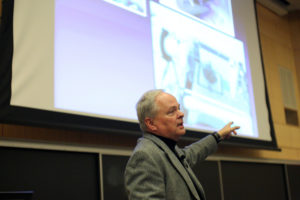by Greg St. Martin
“I love brains,” said Rebecca Shansky, an assistant professor of psychology at Northeastern. “A lot.”
Shansky studies behavioral neuroscience at Northeastern, where she runs the Lab of Neuroanatomy and Behavior in which she and her colleagues examine the neural connections between different parts of the brain, particularly what these connections might reveal about differences between the sexes.
Imagery of the brain’s neural network—which she called a “beautiful thing”—has transformed in recent years thanks to advances in florescent imaging. Using this technique, researchers can tag what neurons they want to examine, which helps them probe the interactions within the neural network to better understand the brain’s structure and the neural biological basis of human behavior. Her job involves examining these colorful images of neural networks day in and day out.

Rebecca Shansky, Assistant Professor in the Department of Psychology
Shansky was among a group of College of Science faculty who presented TED-style talks Thursday night to about 125 students that focused on what fuels their passion for science and discovery. The event, aptly titled “What Lights My Fire,” was the first installment of the new series, which the college hopes to host each semester.
Network scientist Alessandro Vespignani, the Sternberg Family Distinguished Professor of Physics, said his fire is driven by his “inner ‘control-freak’ personality”—though he’s not alone in possessing this trait. Dating back to the discovery of fire itself, he said, people have realized that understanding and controlling their surroundings is key to survival. A primary example of this, he said, is predicting the weather.
Prediction is an integral component of the work of Vespignani and his colleagues in Northeastern’s MoBS Lab, where they develop innovative mathematical models and computational tools to better understand, anticipate, and control large-scale complex networks and systems. “Data alone do not tell you the future. It’s just a picture,” he said. “Models are our crystal ball.”
For his part, Vespignani is the weatherman of predicting pandemics. For months his team has been tracking the Ebola epidemic in West Africa and its potential to spread globally. They use cutting-edge computational modeling to visualize the disease’s potential spread by leveraging population and human mobility data.
Kim Lewis, University Distinguished Professor of Biology, said that microbiology lights his fire, noting that “Microbes interact with each and every creature on the planet” and affect most if not all bodily and cognitive functions. Lewis said his team in the Northeastern’s Antimicrobial Discovery Center attempt to attack many unsolved problems and paradoxes. “Why?” he asked. “Because it’s fun.”
One example is treating chronic infections, which in cases like MRSA actively resist certain antibiotics. His work has focused on a specialized class of cells produced by pathogens called persisters, which lie dormant. But in groundbreaking research published a year ago, Lewis’ presented a novel approach to treat and eliminate the potent bacterium using a drug called ADEPthat effectively wakes up these dormant cells and initiates a self-destruct mechanism.

Mark Patterson, Professor of Marine and Environmental Sciences and Professor of Civil and Environmental Engineering
Patterson, who holds joint appointments in the Department of Marine and Environmental Sciences and the Department of Civil and Environmental Engineering, discussed his fascination with energy metabolism. He directs the Field Robotic Laboratory at Northeastern’s Marine Science Center, where he builds autonomous underwater robots equipped with myriad sensors that can be deployed to scan marine life on the ocean’s floor.
“You can swim these devices over respiring or photosynthesizing landscapes, and you can collect data that show you oxygen transactions at the scale of football fields,” he explained. With these data, he can build mathematical models that show how these ecosystems function.
Originally published in news@Northeastern on November 3, 2014

